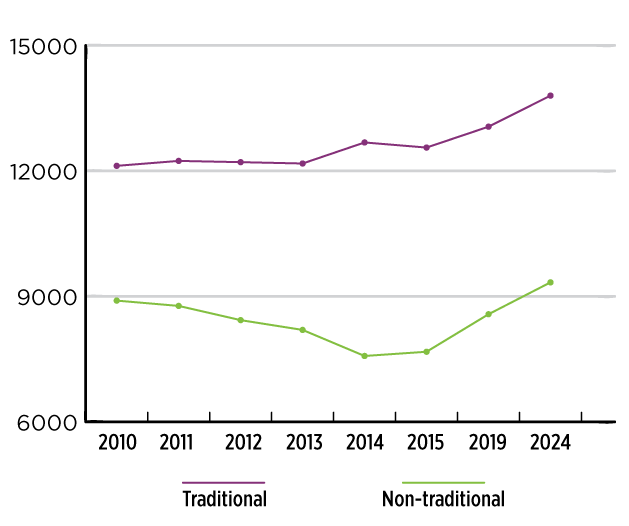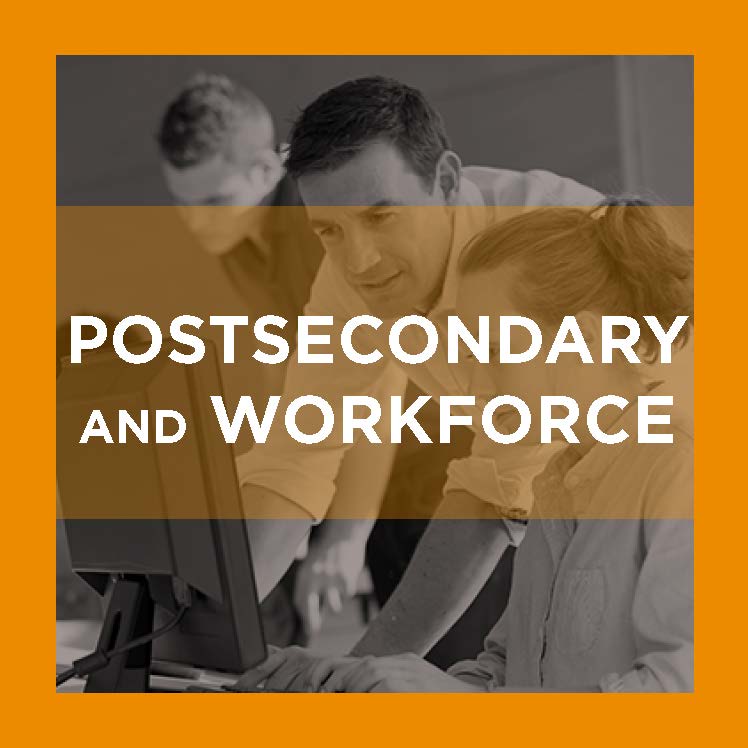When imagining the beginning of a postsecondary experience, one pictures hundreds of students showing up on campus, moving into their dorms and bidding their parents goodbye to begin their independent lives. However, that image has shifted in the past 10 plus years as an increasing adult population arrives on college campuses (either physically or online). NCES points out that even though the number of degree-seeking students under the age of 25 has grown at a higher rate than the adult population, future projections show the adult population growing at a higher percentage. With this influx of the adult-student population, states and institutions need to strategize how to best support these students both academically and financially. In addition, states will not be able to reach their set attainment goals without this important student population.
Fall enrollment in degree-granting institutions of traditional and nontraditional students between 2010 and 2024
Source: National Center for Education Statistics
Total fall enrollment in degree-granting institutions, by attendance status, sex and age: Selected years, 1970 through 2024
Ruffalo Noel Levits and CAEL conducted a survey of adult students from the 2015-16 academic year that found adult learners have different needs than “traditional-aged” students. Some of those needs include:
- Course offering flexibility.
- More course offerings in their major.
- Multiple options for financial aid and billing.
In light of this growing student population, states have introduced or enacted legislation providing student supports for adults.
Florida enacted H.B. 5201 in 2012 which included the Degree Completion Pilot Program to recruit, recover and retain adult learners. This bill also established the Florida Virtual Campus to provide access to online student and library support services. It also serves as a statewide resource and clearinghouse for postsecondary education distance learning courses and degree programs. This provides the flexibility for adult students to utilize these resources at any time of day.
During this year’s legislative session, Tennessee eased the Community College Reconnect Grant requirements to help adult students secure financial assistance when returning to a community college. House Bill 2117 removed the requirement that the associate degree must be an “applied science,” changed the waiting period between leaving an institution and returning from 24 months to 12 months, and requires TSAC (who awards the grants) to distribute funds to public two-year institutions based on their percentage of the total nontraditional students enrolled at each institution. These changes provide wider access to postsecondary funding for adult students returning to complete a credential. Additionally, three states (New Jersey, New York and Washington) introduced legislation that specifically targets the adult-learner population.
As New America Education points out, three major reasons for lower attainment rates among nontraditional students include time to degree, finances and academic preparedness. Typically nontraditional students attend higher education part-time due to other obligations such as full-time employment, family commitments, etc. Research has shown that students attending higher education on a part-time basis are less likely to earn a credential. Financial aid mechanisms are set up to benefit traditional/dependent students and could hinder the ability for a nontraditional student to attend and afford high education. And as nontraditional students are not coming straight from high school they may encounter academic barriers which could prohibit them from progressing in credit-bearing courses.
With barriers in mind and an understanding of the increased adult population, policymakers and institutions should take into consideration the following recommendations:
- Restructure financial aid policies to be flexible for adult-learners.
- Provide multiple avenues to award credit (prior learning assessments, competency-based education, online courses).
- Require student supports at institutions including individual advising opportunities and online resources.
- Create degree maps or degree outlines allowing students to follow a roadmap to completion.
- Provide course availability in multiple formats and days/times.










